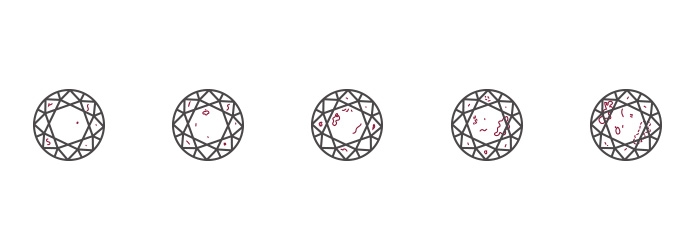When it comes to selecting a diamond, the array of choices can be overwhelming. How do you ensure that you’re making a wise investment? What factors determine the true value and beauty of a diamond? The answer lies in the 4Cs: Cut, Color, Clarity, and Carat. These four characteristics are the global standard for assessing the quality of diamonds. Let’s delve into each of these aspects to understand how they influence a diamond’s overall appeal and value.
1. Understanding the Diamond 4Cs
What Are the 4Cs? The 4Cs—Cut, Color, Clarity, and Carat—are the key metrics for evaluating a diamond’s quality. This standardized grading system was developed by the Gemological Institute of America (GIA) to provide a universal language for comparing diamond quality.
Why Are the 4Cs Important? These criteria are crucial because they directly affect the diamond’s aesthetic appeal and market value. Whether you’re buying a diamond for an engagement ring or as an investment, understanding the 4Cs helps you make an informed decision.
2. The Importance of Cut
What Does Diamond Cut Mean? The cut of a diamond refers to how well it has been shaped and faceted. It is not to be confused with the shape (like round or princess). The cut impacts the diamond’s brilliance and sparkle.
How Is Cut Graded? Cut grades range from Excellent to Poor. A well-cut diamond reflects light beautifully, exhibiting maximum brilliance. Conversely, a poorly cut diamond appears dull and lifeless.
The Impact of Cut on Value A diamond with an excellent cut can command a premium price, as its superior brilliance makes it more desirable. In contrast, even a diamond with high carat weight but a poor cut can be less attractive and valuable.
3. Evaluating Diamond Color
What Is Diamond Color? Diamond color actually refers to the absence of color. The GIA color scale ranges from D (completely colorless) to Z (light yellow or brown).
The Color Grading Scale
- D-F: Colorless. The highest quality, rare diamonds.
- G-J: Near colorless. Excellent value with minimal color visible.
- K-M: Faint color. Noticeable color, but still a good value.
- N-Z: Noticeable color. Typically less desirable for jewelry.
How Color Affects Value Colorless diamonds (D-F) are the most valuable, while diamonds with more noticeable color (K-Z) are less expensive. The choice depends on personal preference and budget.
4. Assessing Diamond Clarity
What Is Diamond Clarity? Clarity measures the presence of internal inclusions or external blemishes. The fewer imperfections, the higher the clarity grade.
Clarity Grading Scale
- FL (Flawless): No inclusions or blemishes visible under 10x magnification.
- IF (Internally Flawless): No inclusions, only minor surface blemishes.
- VVS1-VVS2 (Very Very Slightly Included): Inclusions are very difficult to see.
- VS1-VS2 (Very Slightly Included): Inclusions are observed with effort.
- SI1-SI2 (Slightly Included): Inclusions are noticeable under magnification.
- I1-I3 (Included): Inclusions are obvious and may affect transparency and brilliance.
The Role of Clarity in Value High clarity grades (FL, IF) are rare and more expensive. However, many inclusions are not visible to the naked eye, making diamonds with lower clarity grades (VS1-SI2) a good value.
5. Understanding Carat Weight
What Is Carat Weight? Carat refers to the weight of the diamond. One carat equals 200 milligrams.
How Carat Weight Is Measured Carat is subdivided into 100 points. For example, a 0.50-carat diamond is also known as a 50-point diamond.
The Impact of Carat Weight on Price Generally, larger diamonds are more valuable, but carat weight alone does not determine value. A smaller diamond with excellent cut, color, and clarity can be more desirable than a larger diamond with poor qualities in these areas.
6. Balancing the 4Cs
Prioritizing Your Preferences When choosing a diamond, it’s essential to balance the 4Cs based on personal preference and budget. For instance, if brilliance is your priority, you might focus on an excellent cut even if it means compromising slightly on color or clarity.
Tips for Buying Diamonds
- Set a Budget: Determine what you’re willing to spend and understand how the 4Cs will affect your options within that budget.
- Prioritize Cut: A well-cut diamond maximizes brilliance, often compensating for lower color or clarity grades.
- Consider Color and Clarity: Near colorless diamonds (G-J) offer excellent value, and inclusions in the VS2-SI1 range are typically not visible to the naked eye.
- Choose Carat Weight Wisely: Decide on a size that suits your style and budget. Remember, a slightly smaller diamond with better cut, color lab grown diamonds, and clarity might be a better choice.
7. Conclusion: Making an Informed Choice
Choosing a diamond is a significant decision that combines personal taste with investment considerations. By understanding the 4Cs—Cut, Color, Clarity, and Carat—you can make an informed choice that balances beauty and value. Remember, the most important factor is what appeals to you personally. A diamond is not just a gem; it’s a symbol of lasting commitment and timeless beauty.
So, next time you’re in the market for a diamond 4cs chart, will you know exactly what to look for? Can you balance the 4Cs to find the perfect stone that speaks to you? Armed with this knowledge, you’re well-equipped to make a choice that will bring joy for years to come.
